Be the Mermaid
Maritime Museum Exhibit Celebrates the Art of Being a Mermaid
By Maggie Yates | November 11, 2021
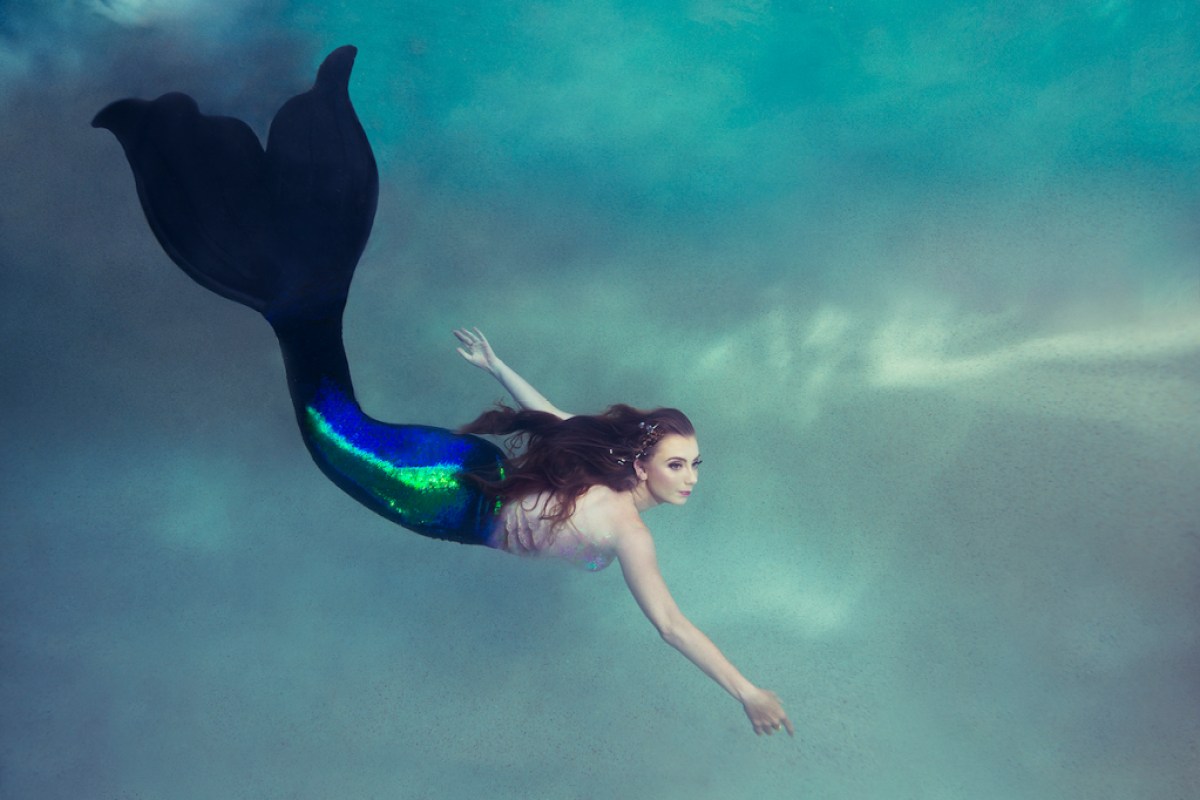
SHINE ON: Erin M. Brydon’s photo captures the ideal of mermaid undersea serenity.
In the limitless blue sea, iridescence glimmers off the scales of her slick and powerful tail. She is graceful and glamorous, a dancer of the depths, this mermaid captured on camera. Jewels in her hair, gills at her ribs, the model in Erin Brydon’s photograph is a vision of pin-up perfection, but she is not a Photoshopped fantasy. This magic illusion is evidence of collaboration between a photographer and a trained mermaid model — as close to a real mermaid as you can get.
This image, part of the exhibit Mermaids: Visualizing the Myths and Legends Through Photography, is one of many on display at the Santa Barbara Maritime Museum. The show celebrates the work of Brooks Institute photographers who’ve done the impossible: captured images of mermaids in the wild. Specifically, they took these images in the ocean off the Channel Islands, where they found their subjects deep in ocean lore.
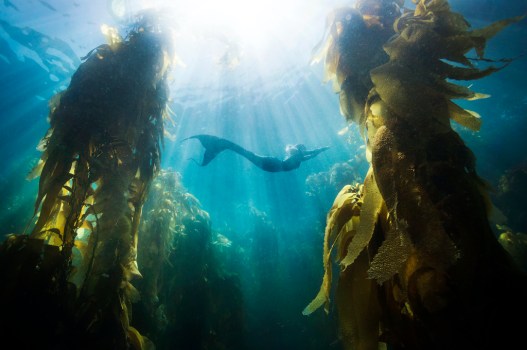
Mermaids have universal appeal. These beings with human intelligence can live underwater in a world that we can only access with vehicles and gear. They combine strength and sensuality in an appealing way that exudes the aura of freedom a romanticized life at sea offers.
At a critical point in my life, a moment of emotional doldrums, I saw a T-shirt that said, “Always be yourself. Unless you can be a mermaid, then be a mermaid.” Desperate to redefine my existence, I seized on a radical notion: Screw being myself; I was going to be a mermaid. There is a power in manifestation — creating reality out of fantasy — and I started the process by growing my hair. What if I didn’t have to be myself all the time? What if, instead, I could be a beautiful, carefree being from the mysterious depths?
The tail came next. Sleek and shimmering, the single big fin binds the legs, forcing a vertical undulation of the body to propel through the water. The monofin in the fluke of the tail allows the wearer to glide gently through the deep (unlike the spastic kicking of two feet). Finally, I took the literal plunge at mermaid school, where I became acquainted with an entire culture of merpeople. I’m not the only person, it seems, with mermaid dreams: People of all genders from all corners of the world harbor the fantasy of diving deep and swimming effortlessly as the legendary human/sea-creature hybrid. Exploring the world of mermaiding was akin to developing a superpower: I feel athletic and silky underwater, a transformation from the chaos of a merely human body submerged. It’s a non-narcotic way of transcending the customariness of life and experiencing the world in an utterly new way.
From children in Halloween costumes to professional mermaid performers and models (mermodels), there is an entire subculture of people who dream of life underwater. I love meeting other mermaids and hearing their stories, including a young trans woman in a rainbow tail at the Madonna Inn pool, celebrating pride, and a couple in their fifties who rocked teal hair and tails to spread awareness about ovarian cancer. There’s even a mermaid convention every year in Sacramento for merpeople to come together and celebrate their shared fascination (and shop, shop, shop!).
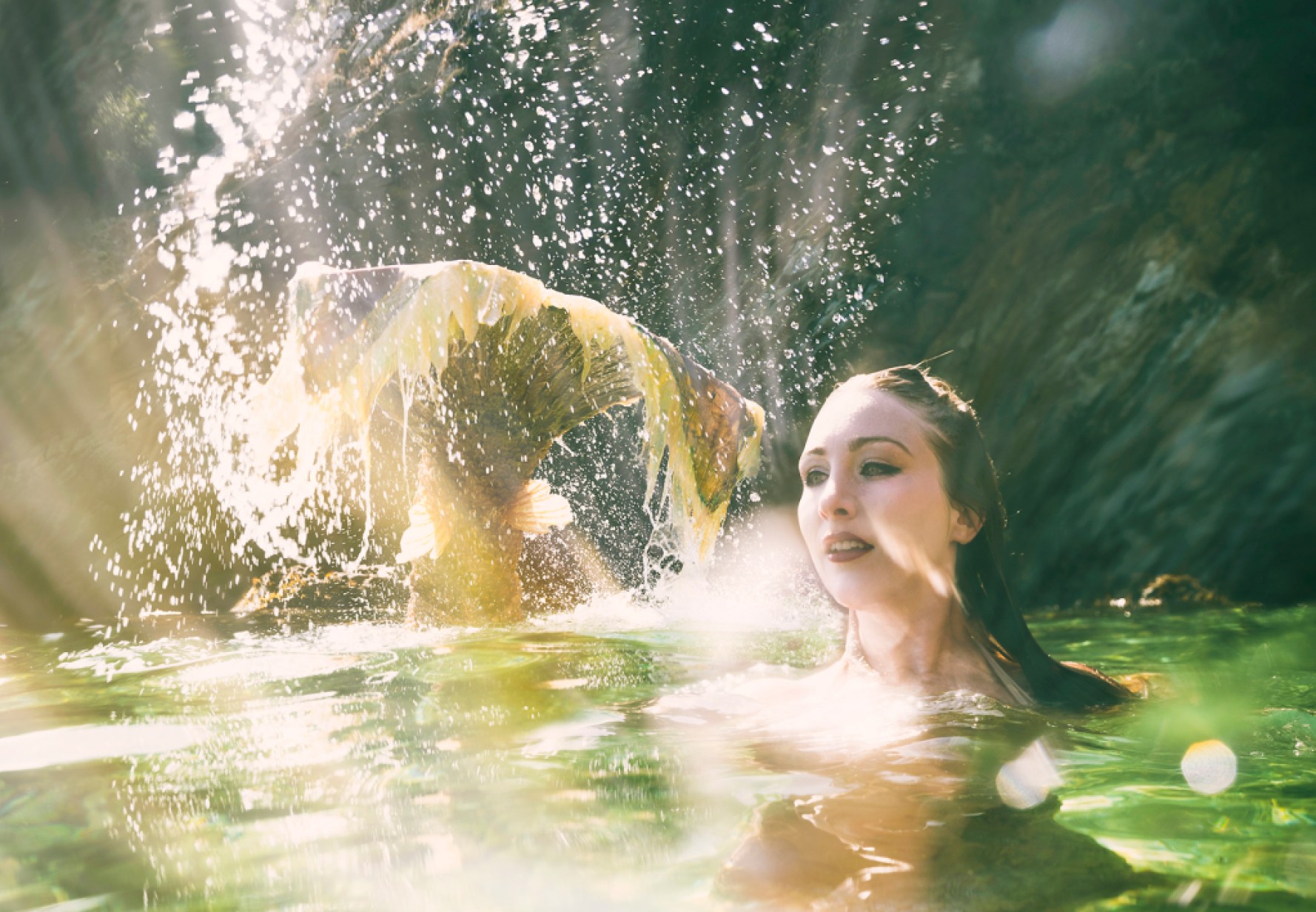
Professional mermaids are a focused version of the mermaid hobbyist. These mermodels are generally excellent swimmers; many also know how to free-dive, and they all practice the art of underwater posing. In Chiara Salomoni’s photo, we see the active arms and relaxed expression of the kind of skillful poses that experienced mermaids achieve as they float, unaffected by the laws of physics, in the blue depth. These mermodels are magically fluid in the watery environment around them, and their elaborate costumes hint at the splendors under the sea.
The photographers who shot these images in the channel developed them at the Brooks Institute of Photography, where the next generation of photographers once studied their craft. Senior faculty member and photographer Ralph A. Clevenger taught a course on underwater photography. A highlight of the Brooks experience was the class journey to the Channel Islands on a dive boat to take underwater images of fashion models. In preparation for one of these trips, Clevenger learned about the existence of professional mermaids from a student.
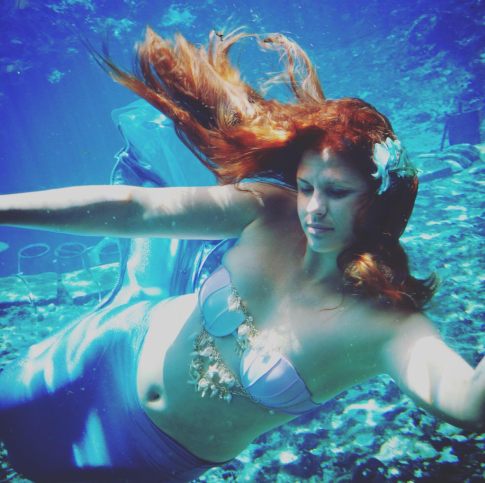
The benefit of using mermaids as subjects when learning underwater photography is that students can tell fabulous stories with their images rather than just capturing fashion underwater. For example, in John Kelsey’s image, the mermaid swims languidly through towers of kelp in an undersea forest. Light streaming around the mermaid’s form in silhouette gives an otherworldly appeal to the familiar kelp, making it easy to imagine that these fascinating aquatic creatures do exist, concealed in the underwater features just offshore.
There are myriad technical challenges in creating underwater images of mermodels. For one thing, without the benefit of masks or goggles, the mermaids are blind underwater, making communication during the actual shoot impossible. They also need to come up for air every few minutes, as does the photographer if not in SCUBA gear. The dive crews for these Brooks shoots were very safety-conscious, with safety divers in the water with the models to offer assistance and air from their SCUBA tanks. The sea surge also swirls the models’ hair and lifts their bodies toward the surface. Creating neutral buoyancy without the weight belt that the divers wear is difficult, and sometimes it’s necessary to place weights on the mermaid tail to keep the mermodels from floating upward. It takes a lot of shots to get the perfect combination of flowing hair, facial expression, and flattering body shape, all without verbal communication between models and photographers.
Beyond that, the mermaid costume — generally a cloth or silicone tail with a monofin flipper and an embellished shell breastplate — does not offer an abundance of warmth, and the waters of the channel are cold; the mermaids could only model for short periods of time before needing a break on the surface with a warm shower.
Clevenger worked with curator Emily Falke to create this stunning exhibit for the Maritime Museum. Together, they selected 16 images from the work of Clevenger and his students, several of whom are now professional photographers. They then printed them at life size. “When you see the exhibit, you’re standing in front of these bodies that are the size of yours, so you feel like you’re in the water with them,” says Falke. “These are very glamorous — even almost sort of provocative in some ways — sensual, beautiful photographs.”
The accompanying text tells the stories of mermaid myths from all over the world, as far back as ancient Assyria. In the Western European canon of myths, the mermaids were known to foretell bad luck on the sea, such as a storm or a shipwreck. The mermaid myth became inexorably intertwined with the siren myth along the trail of history, and the idea of mermaids as temptresses whose song lured men into the ocean so they could be drowned became a popular motif in art and folktales. This vicious history behind the glamour adds a level of femme-fatale energy (what Falke refers to as “girl-power”) to the stories told by the images. “They’re kind of daring,” she says. “They were taking the sailors down! They are not just these Botticelli-esque creatures; they were tough cookies!”
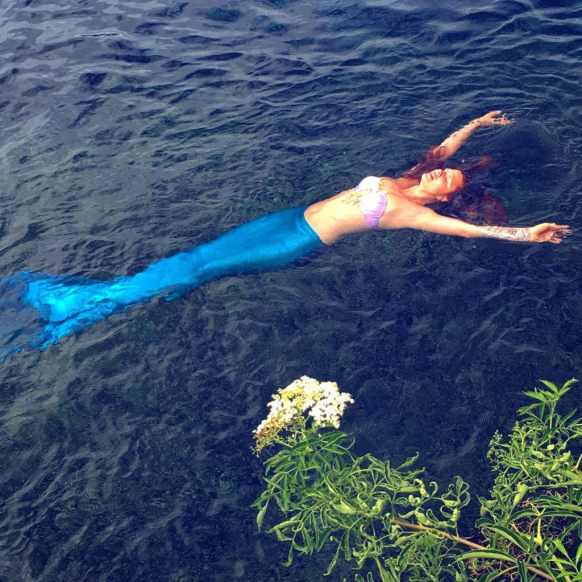
Clevenger, a lifelong diver, is the opposite of the unlucky sailor in that the mermaid tribe he’s discovered is eager for collaboration. His photo of a golden mermaid presents the idea of mermaids interacting with the camera and crew, another enticing fantasy. Her flirty pose begs the question: Are humans and mermaids compatible? “It’s a great story,” says Clevenger. “With the cross-cultural connection with lakes and oceans and how people relate to those places … it doesn’t surprise me that people made gods and goddesses and myths based on the ocean.”
The museum exhibit, which opens November 11, wouldn’t be complete without a live mermaid sighting, so don’t miss the mermodels in the harbor on November 13, ready for photo ops (sign up for a photography slot at sbmm.org).
The reality behind being a mermodel or a mermaid performer is that it involves hard work. Creating these illusions goes far beyond donning a tail; mermaids should look like aquatic beings who don’t need to hold their breath. Especially for photography or performance, there is an art to looking natural underwater, and it takes practice.
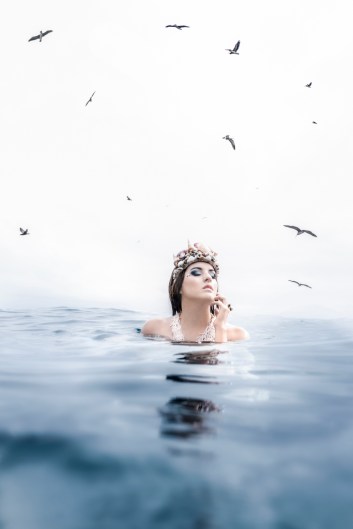
My journey to mermaidhood began in Weeki Wachee Springs, Florida, where performing mermaids have entertained audiences in an underwater arena since the 1940s. After World War II, former navy trainer Newton Perry started a mermaid academy there. He trained young women to swim in the mermaid tail, synchronize their movements, and smile naturally for the fans — all while at least five feet underwater. The mermaid performers could catch a breath of oxygen through air hoses hidden throughout the sizeable spring pool. Back when the Weeki Wachee mermaid show was a roadside attraction on a two-lane highway, Perry’s performers would stand on the side of the road to entice cars to stop at the spring, not unlike the legends of mermaids luring sailors into the rocky shoals.
Three-quarters of a century later, the mermaid magic still happens in Weeki Wachee, though the roadside attraction is now a state park with water slides and kayaking. There is a new generation of mermaids now, but the legendary sirens of the deep (mermaid alumni) teach a mermaid “boot” camp at the Weeki Wachee amphitheater. I attended this mermaid school in 2019, and a woman in her eighties, a Weeki Wachee mermaid from the 1950s (she performed for Elvis Presley in her heyday and is still an extraordinary swimmer) taught me to swim in the mermaid tail. I learned some basic underwater acrobatics and how to look natural while posing underwater. No part of this was an easy task, but a sense of calm in underwater endeavors makes the mermaid experience transcendent. (And there’s something rather energizing about knowing you have the power to lure sailors to their death, should you choose. Though in Weeki Wachee, where the mermaids are friendly, the interactions with landlubbers involved more flicking the tail fin at enchanted children than drowning unlucky seafarers.)
Nowadays, I’m a mermaid anywhere I can take the tail for good swimming, including our local beaches. Mainly, my mermaid alter ego gives me a chance to be more present in the aquatic environment, genuinely feeling the magical mysteries of the deep. In a culture that demands some level of conformity, it’s a pleasure to have a way to celebrate impracticality, especially one that connects me to the ocean, such a force in our natural world and the culture of Santa Barbara. As a coastal city, we have a connection with the sea right at our doorstep, and the mermaid experience exemplifies that relationship.
Becoming a mermaid didn’t solve any of my problems, but it made life more enjoyable. It offered me a fantasy life that I’d been lacking, and on days when I find it difficult to be myself, I remember that I can be a mermaid instead — undoubtedly the preferred option.




You must be logged in to post a comment.